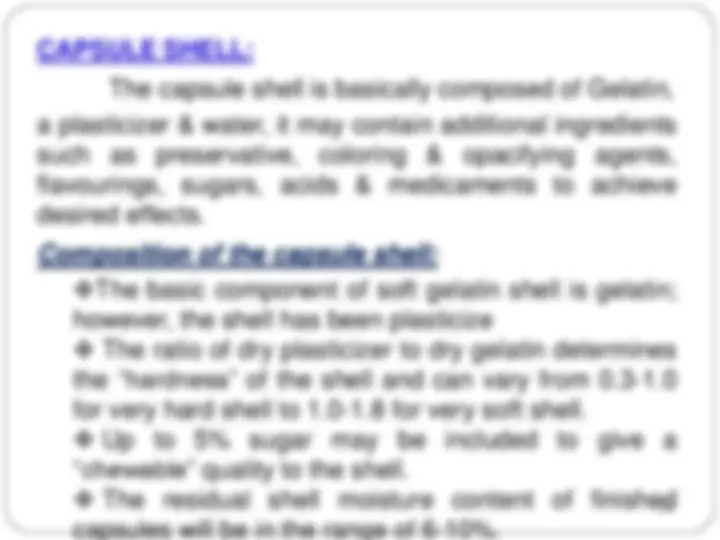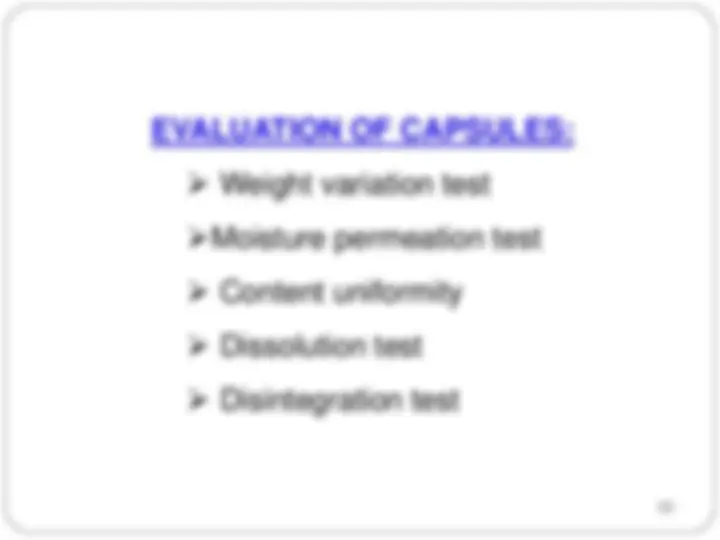



























































Study with the several resources on Docsity

Earn points by helping other students or get them with a premium plan


Prepare for your exams
Study with the several resources on Docsity

Earn points to download
Earn points by helping other students or get them with a premium plan
Community
Ask the community for help and clear up your study doubts
Discover the best universities in your country according to Docsity users
Free resources
Download our free guides on studying techniques, anxiety management strategies, and thesis advice from Docsity tutors
Information on capsules, their types, formulation,etc
Typology: Slides
1 / 65

This page cannot be seen from the preview
Don't miss anything!


























































12 July 2018
Capsules are solid dosage forms in which the drug substance is enclosed within either a hard or soft soluble shell, usually formed from gelatin. The term capsule is derived from the Latin word capsula, meaning a small container. The medication may be a powder, a liquid or a semisolid mass. Capsules are usually intended to be administered orally by swallowing them whole. Occasionally, capsules may be administered rectally or vaginally. 1
ADVANTAGES OF CAPSULES: Capsules are tasteless, odorless and can easily be administered. Combination of powders we can use There are attractive in appearance. The drugs having un-pleasant odor and taste are enclosed in a tasteless shell. They can be filled quickly and conveniently. Physician can change the dose and combination of drug according to patient requirement. They are economical. They are easy to handle and carry. The ready solubility of gelatin at gastric pH provides rapid release of medication in the stomach. Packaged and shipped by manufacturers at lower cost less breakage than liquid forms. 3
Capsules are not suitable for liquids that dissolve gelatin, such as aqueous or hydro alcoholic solutions. The concentrated solutions which require previous dilution are unsuitable for capsules because if administered as such lead to irritation into stomach. Not useful for efflorescent or deliquescent materials. Efflorescent cause capsules to soften & Deliquescent may dry the capsule shell to brittleness. 4
Size Volume in ml Size in mm 000 1.37 26. 00 0.95 23. 0 0.68 21. 1 0.50 19. 2 0.37 18. 3 0.30 15. 4 0.21 14. 5 0.15 11.
6
Gelatin is heterogeneous product derived by hydrolytic extraction of animal's collagen. The sources of gelatins including animal bones, hide portions and frozen pork skin. It is the major component of the capsule. The reason for this is that gelatin possesses five basic properties: A- Non-toxic. B- Soluble in biological fluids at body temperature. C- It is a good film-forming material. D- Solutions of high concentration, 40 % w/v, are mobile at 50 °C. E- A solution in water changes from a sol to a gel at temperatures only a few degrees above ambient 9
10
There are two basic types of gelatin
1 Bloom value; Is a measurement of the gelling power and the strength of the resulting gel. Gelatin generally falls between 50 and 300 bloom strength. 2 Gelling power; The key function of gelatin. The gelling power varies depending on the grade of gelatin Its measured in terms of bloom value. The higher 13
5. Melting point; Lower melting point gelatins dissolve faster in the mouth, therefore releasing the flavors more quickly for an instant taste sensation. Lower bloom grades tend to have lower melting points. 6. Color and odor; The gelatin should be as clear as possible in solution. Clarity is measured using a turbidimeter. The gelatin should be without odor. 7. Conductivity; is a key parameter in photographic applications and grades of the highest purity with minimal or no conductivity are required. De-ionized grades have an advantage because of their low conductivity. 8. pH; pH is measured using a pH meter on a 1 % solution 15
Capsules are available in two types: 1.Hard gelatin capsules 2.Soft gelatin capsules. 1.Hard gelatin capsule (^) 2.Soft gelatin capsule 16
18
Pairs of the stainless steel pins are dipped into the dipping solution to simultaneously form the caps and bodies. The dipping solution is maintained at a temperature of about 500 C in a heated, jacketed dipping pan. 2 .SPINNING: The pins are rotated to distribute the gelatin over the pins uniformly and to avoid the formation of a bead at the (^19)